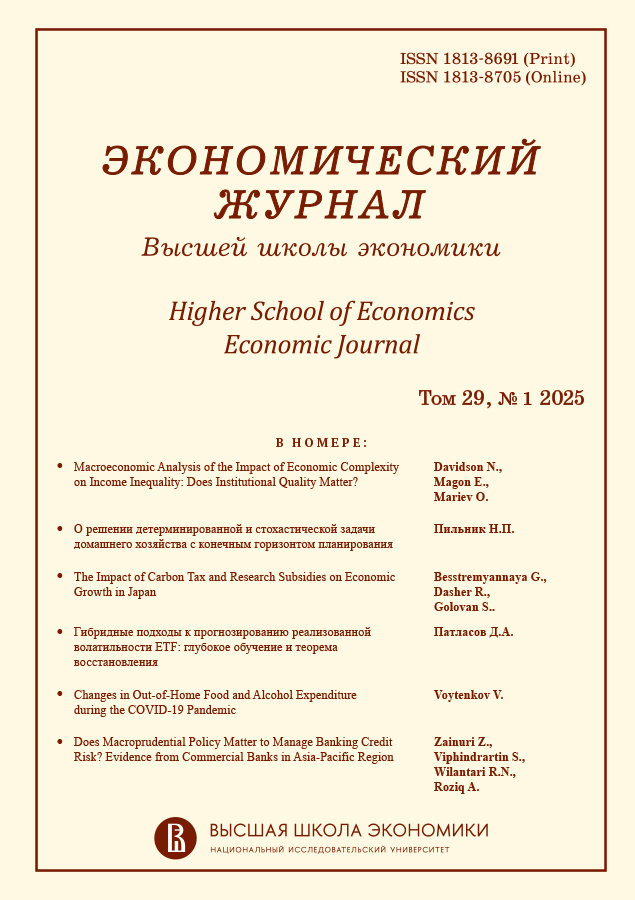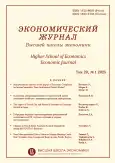Изменения в расходах на питание и алкоголь вне дома во время пандемии COVID-19
- Авторы: Войтенков В.А.1
-
Учреждения:
- Национальный исследовательский университет «Высшая школа экономики»
- Выпуск: Том 29, № 1 (2025)
- Страницы: 132-159
- Раздел: Статьи
- URL: https://journal-vniispk.ru/1813-8691/article/view/287578
- DOI: https://doi.org/10.17323/1813-8691-2025-29-1-132-159
- ID: 287578
Цитировать
Полный текст
Аннотация
В данном исследовании изучаются изменения в расходах на питание и алкоголь вне дома во время пандемии COVID-19. Исследование посвящено изучению межгрупповых различий между домохозяйствами с учетом различий российских регионов по степени соблюдения карантинных ограничений. Для проверки гипотез исследования мы используем микроданные обследования бюджетов домашних хозяйств, проводимого Федеральной службой государственной статистики. Для сравнения расходов на питание и алкоголь вне дома в регионах с мягкими, средними и жесткими ограничительными мерами мы используем t-тест для сравнения средних и тест Колмогорова – Смирнова для сравнения распределений. Модель Тобита применяется для сравнения привычек домохозяйств разных социальных групп. Совместный анализ внедомашних расходов на еду и алкоголь позволяет отделить непроизвольные сбережения от стратегий преодоления, используя модели для цензурированных данных, что способствует углубленной оценке благосостояния домохозяйств в условиях потрясений. Полученные результаты свидетельствуют о сокращении расходов на продукты питания вне дома во всех социальных группах и при всех уровнях карантинных ограничений. Доля расходов на алкоголь снизилась почти во всех социальных группах в регионах с мягкими мерами, но значительно увеличилась в регионах со средними и жесткими ограничениями.
Об авторах
Валентин Александрович Войтенков
Национальный исследовательский университет «Высшая школа экономики»
Автор, ответственный за переписку.
Email: vvoytenkov@hse.ru
стажер-исследователь в Научно-учебной лаборатории пространственно-эконометрического моделирования социально-экономических процессов
Россия, МоскваСписок литературы
- Abebe G.K., Charlebois S., Music J. (2022) Canadian Consumers’ Dining Behaviors during the COVID-19 Pandemic: Implications for Channel Decisions in the Foodservice Industry. Sustainability, 14, 9, pp. 1–21.
- Acharya B., Dhakal C. (2022) Risky Health Behaviors during the COVID-19 Pandemic: Evidence from the Expenditures on Alcohol, Non-alcoholic Beverages, and Tobacco Products. PLoS One, 17, 5, pp. 1–14.
- Alonso L.E., Rodríguez C.J.F., Rojo R.I. (2015) From Consumerism to Guilt: Economic Crisis and Dis courses about Consumption in Spain. Journal of Consumer Culture, 15, 1, pp. 66–85.
- Ammar A., Brach M., Trabelsi K., Chtourou H., Boukhris O., Masmoudi L., Bouaziz B., Bentlage E., How D., Ahmed M. (2020) Effects of COVID-19 Home Confinement on Eating Behaviour and Physical Activity: Results of the ECLB-COVID19 International Online Survey. Nutrients, 12, 6, pp. 1–13.
- Anderson P., O’Donnell A., Llopis E. J., Kaner E. (2022) The COVID-19 Alcohol Paradox: British Hou sehold Purchases during 2020 Compared with 2015–2019. PLoS One, 17, 1, pp. 1–13.
- Antonov S. (2024) How Much Alcohol Is Drunk in Russia. Tinkoff Journal. Available at: https://t-j.ru/ drunkards/ (Retrived 10.02.2025).
- Avery A.R., Tsang S., Seto E.Y.W., Duncan G.E. (2020) Stress, Anxiety, and Change in Alcohol Use during the COVID-19 Pandemic: Findings among Adult Twin Pairs. Frontiers in Psychiatry, 11, pp. 1–12.
- Baker S.R., Farrokhnia R.A., Meyer S., Pagel M., Yannelis C. (2020) How Does Household Spending Respond to an Epidemic? Consumption during the 2020 COVID-19 Pandemic. The Review of Asset Pricing Studies, 10, 4, pp. 834–862.
- Barigozzi M., Alessi L., Capasso M., Fagiolo G. (2012) The Distribution of Household Consumption-Expenditure Budget Shares. Structural Change and Economic Dynamics, 23, 1, pp. 69–91.
- Becker G.S. (1965) A Theory of the Allocation of Time. The Economic Journal, 75, 299, pp. 493–517.
- Becker G.S. (2009) Human Capital: A Theoretical and Empirical Analysis, with Special Reference to Education. University of Chicago Press.
- Blundell R., Costa Dias M., Cribb J., Joyce R., Waters T., Wernham T., Xu X. (2022) Inequality and the COVID-19 Crisis in the United Kingdom. Annual Review of Economics, 14, pp. 607–636.
- Blundell R., Chen X., Kristensen D. (2007) Semi‐Nonparametric IV Estimation of Shape‐Invariant Engel Curves. Econometrica, 75, 6, pp. 1613–1669.
- Chen H., Qian W., Wen Q. (2021) The Impact of the COVID-19 Pandemic on Consumption: Learning from High-Frequency Transaction Data. AEA Papers and Proceedings, 111, pp. 307–311.
- Chen R., Li T., Li Y. (2024) Analyzing the Impact of COVID-19 on Consumption Behaviors through Recession and Recovery Patterns. Scientific Reports, 14, 1, pp. 1–14.
- Cutler D.M., Lleras-Muney A. (2010) Understanding Differences in Health Behaviors by Education. Journal of Health Economics, 29, 1, pp. 1–28.
- Dhakal C., Acharya B., Wang S. (2022) Food Spending in the United States during the First Year of the COVID-19 Pandemic. Frontiers in Public Health, 10, pp. 1–7.
- Edelstein P., Kilian L. (2009) How Sensitive Are Consumer Expenditures to Retail Energy Prices? Journal of Monetary Economics, 56, 6, pp. 766–779.
- Federal State Statistics Service. (2022) Household Budget Survey. Available at: https://obdx.gks.ru/ (Retrieved: 23.10.2023).
- Gautier E., Ulgazi Y., Vertier P. (2020) Inflation and Households’ Inflation Expectations during the Covid-19 Pandemic. Banque De France, Eco Notepad, 171. pp. 1–4.
- Greene W.H. (2008) Limited Dependent Variables – Truncation, Censoring and Sample Selection. Econometric Analysis, pp. 833–834.
- Grigoryev L.M., Elkina Z.S., Mednikova P.A., Serova D.A., Starodubtseva M.F., Filippova E.S. (2021) The Perfect Storm of Personal Consumption. Voprosy Ekonomiki, 10, pp. 27–50.
- Hacıoğlu-Hoke S., Känzig D.R., Surico P. (2021) The Distributional Impact of the Pandemic. European Economic Review, 134, pp. 1–19.
- Hausman J.A., Newey W.K., Powell J.L. (1995) Nonlinear Errors in Variables Estimation of Some Engel Curves. Journal of Econometrics, 65, 1, pp. 205–233.
- Jacob L., Smith L., Armstrong N.C., Yakkundi A., Barnett Y., Butler L., McDermott D.T., Koyanagi A., Shin J.Il, Meyer J. (2021) Alcohol Use and Mental Health during COVID-19 Lockdown: A Cross-Sectional Study in a Sample of UK Adults. Drug and Alcohol Dependence, 219, pp.1–5.
- Janssen M., Chang B.P., Hristov H., Pravst I., Profeta A., Millard J. (2021) Changes in Food Consump tion during the COVID-19 Pandemic: Analysis of Consumer Survey Data from the First Lockdown Period in Den mark, Germany, and Slovenia. Frontiers in Nutrition, 8, pp. 1–20.
- Kolomak E.A. (2020) Economic Effects of Pandemic-Related Restrictions in Russia and their Spatial Heterogeneity. R-Economy, 6, 3, pp. 154–161.
- Lazarus R.S. (1984) Stress, Appraisal, and Coping. Springer.
- Lee S.A. (2020) Coronavirus Anxiety Scale: A Brief Mental Health Screener for COVID-19 Related Anxiety. Death Studies, 44, 7, pp. 393–401.
- Leone L.A., Fleischhacker S., Anderson-Steeves B., Harper K., Winkler M., Racine E., Baquero B., Gittelsohn J. (2020) Healthy Food Retail during the COVID-19 Pandemic: Challenges and Future Directions. International Journal of Environmental Research and Public Health, 17, 20, pp. 1–14.
- Leser C.E.V. (1963) Forms of Engel Functions. Econometrica: Journal of the Econometric Society, pp. 694–703.
- Lukashina E. (2020). Strategy of Socio-Economic Development of The Kaluga Region Until 2030. Half of the Way Is Passed. Innovacionnaya Ekonomika i Sovremennyj Menedzhment, 5, pp. 25–30.
- Maniriho A., Musabanganji E., Nkikabahizi F., Ruranga C., Lebailly P. (2021) Analysis of the Determi nants of Households’ Expenditures in Rwanda. UKH Journal of Social Sciences, 5, 1, pp. 1–10.
- Marano G., Traversi G., Gaetani E., Pola R., Claro A.E., Mazza M. (2022) Alcohol Use Disorder and Liver Injury Related to the COVID-19 Pandemic. World Journal of Hepatology, 14, 10, pp. 1875–1883.
- Mareeva S. (2020) Socio-Economic Inequalities in Modern Russia and their Perception by the Popu lation. The Journal of Chinese Sociology, 7, 1, pp. 1–19.
- Monden C.W.S., Van Lenthe F., De Graaf N.D., Kraaykamp G. (2003) Partner’s and Own Education: Does Who You Live with Matter for Self-Assessed Health, Smoking and Excessive Alcohol Consumption? Social Science & Medicine, 57, 10, pp. 1901–1912.
- Murashov Y., Ratnikova T. (2017) The Dynamics of Unrecorded Income of Russian Households. Ap plied Econometrics, 2, 46, pp. 30–54.
- Nartikoev A.R., Peresetsky A.A. (2021) Endogenous Household Classification: Russian Regions. Vop rosy Ekonomiki, 5, pp. 107–128.
- Padel S., Foster C. (2005) Exploring the Gap between Attitudes and Behaviour: Understanding Why Consumers Buy or Do not Buy Organic Food. British Food Journal, 107, 8, pp. 606–625.
- Pišot S., Milovanović I., Šimunič B., Gentile A., Bosnar K., Prot F., Bianco A., Lo Coco G., Bartoluci S., Katović D. (2020) Maintaining Everyday Life Praxis in the Time of COVID-19 Pandemic Measures (ELP-COVID-19 survey). European Journal of Public Health, 30, 6, pp. 1181–1186.
- Potapenko V.V, Shirov A.A. (2021) Forecast of Russian Personal Consumption Expenditures As Fun ction of Income Distribution and Relative Prices. Studies on Russian Economic Development, 1, 184, pp. 6–18.
- Pu C., Lan V., Chou Y.-J., Lan C. (2008) The Crowding-Out Effects of Tobacco and Alcohol Where Ex penditure Shares Are Low: Analyzing Expenditure Data for Taiwan. Social Science & Medicine, 66, 9, pp. 1979–1989.
- Rahman M.A., Hoque N., Alif S. M., Salehin M., Islam S. M.S., Banik B., Sharif A., Nazim N.B., Sultana F., Cross W. (2020) Factors Associated with Psychological Distress, Fear and Coping Strategies during the COVID-19 Pandemic in Australia. Globalization and Health, 16, 1, pp. 1–15.
- Rausch S., Metcalf G.E., Reilly J.M. (2011) Distributional Impacts of Carbon Pricing: A General Equi librium Approach with Micro-data for Households. Energy Economics, 33, pp. 20–33.
- Salehi-Isfahani D. (2023) The Impact of Sanctions on Household Welfare and Employment in Iran. Middle East Development Journal, 15, 2, pp. 189–221.
- Schmits E., Glowacz F. (2022) Changes in Alcohol Use during the COVID-19 Pandemic: Impact of the Lockdown Conditions and Mental Health Factors. International Journal of Mental Health and Addiction, 20, 2, pp. 1147–1158.
- Seliverstov V.E., Kravchenko N.A., Klistorin V.I., Yusupova A.T. (2021) Russian Regions and the Fe deral Center Against Global Threats: A Year of Fighting COVID-19. Regional Research of Russia, 11, pp. 405–418.
- Soberon-Ferrer H., Dardis R. (1991) Determinants of Household Expenditures for Services. Journal of Consumer Research, 17, 4, pp. 385–397.
- Sobol M., Blachnio A., Przepiorka A. (2020) Time of Pandemic: Temporal Perspectives Related to Compliance with Public Health Regulations Concerning the COVID-19 Pandemic. Social Science & Medicine, 265, pp. 1–5.
- St. Petersburg Policy Foundation (2020) Rating of the Petersburg Policy Foundation. Available at: https://www.fpp.spb.ru/fpp-rating-2020-04 (Retrived 06.04.2023).
- Thaler R. (1985) Mental Accounting and Consumer Choice. Marketing Science, 4, 3, pp. 199–214.
- Tobin J. (1958) Estimation of Relationships for Limited Dependent Variables. Econometrica: Journal of the Econometric Society, pp. 24–36.
- Varlamova J., Larionova N. (2015) Macroeconomic and Demographic Determinants of Household Expenditures in OECD Countries. Procedia Economics and Finance, 24, pp. 727–733.
- Verter N., Osakwe C.N. (2014) A Time Series Analysis of Macroeconomic Determinants of Household Spending in the Era of Cross-Cultural Dynamics: Czech Republic As a Case Study. Procedia Economics and Finance, 12, pp. 733–742.
- Voytenkov V., Demidova O. (2023) Impact of COVID-19 on Household Consumption in Russia. Ap plied Econometrics, 72, pp. 73–99.
- Xiong J., Tang Z., Zhu Y., Xu K., Yin Y., Xi Y. (2021) Change of Consumption Behaviours in the Pandemic of COVID-19: Examining Residents’ Consumption Expenditure and Driving Determinants. International Jour nal of Environmental Research and Public Health, 18, 17, pp. 1–15.
- Yen S.T., Jensen H.H. (1996) Determinants of Household Expenditures on Alcohol. Journal of Con sumer Affairs, 30, 1, pp. 48–67.
- Yukseltan E., Kok A., Yucekaya A., Bilge A., Aktunc E.A., Hekimoglu M. (2022) The Impact of the COVID-19 Pandemic and Behavioral Restrictions on Electricity Consumption and the Daily Demand Curve in Turkey. Utilities Policy, 76, pp. 1–17.
Дополнительные файлы










